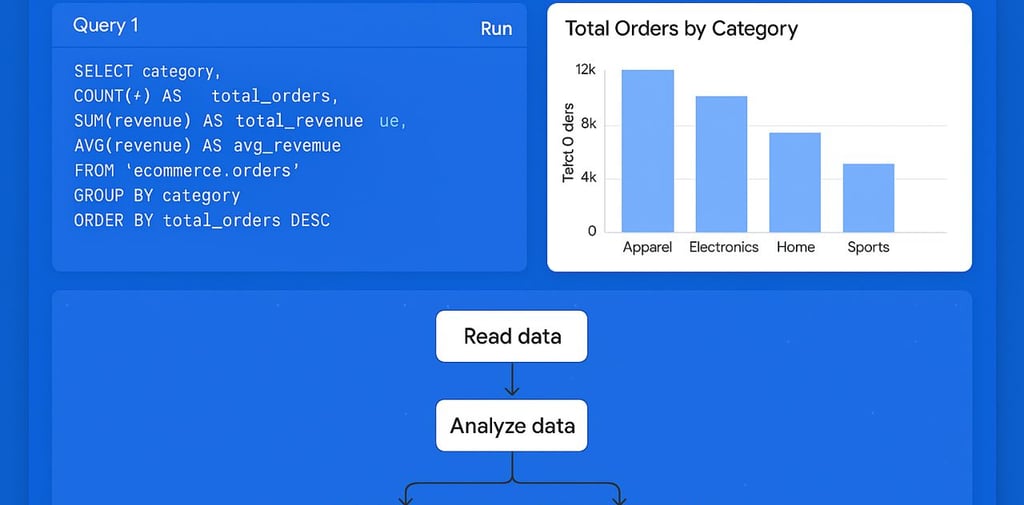
Master Tech skills on the go...
How to Use Google Gemini for Data Analysis and Automation
Harness Google Gemini’s AI-driven data analysis and no-code automation to optimize processes, generate real-time insights and convert more leads into clients
AI TOOLS & PROMPT ENGINEERING
By OnlineTechSkills Editorial Team
5/30/20255 min read


Introduction
In today's hyper‑competitive marketplace, the ability to rapidly analyze vast datasets and seamlessly automate workflows can make or break a business. You're likely familiar with the hours spent cleaning data in spreadsheets, stitching together insights across disconnected tools, and manually sending reports to stakeholders only to repeat the cycle each month. Enter Google Gemini: Google's next-generation AI platform designed to unify powerful data analysis with end-to-end automation, all through an intuitive interface.
Imagine querying sales performance in natural language, generating a forecast, and triggering an email alert when figures dip without writing a line of code. Or crafting bespoke dashboards that update in real time, enabling you to proactively address client needs. That's the promise of Google Gemini, and in this comprehensive guide, we'll show you exactly how to harness its capabilities to transform raw data into automated, client‑winning insights.
By the end of this article, you'll understand why organizations across industries are adopting Gemini to streamline data workflows, impress prospects with dynamic analytics, and ultimately convert more leads into loyal clients.
Understanding Google Gemini
Google Gemini is not just another AI service, it's an integrated platform combining three core modules:
Gemini Analysis Studio: An interactive environment for data exploration and model building.
Gemini Automator: A no-code workflow engine for automating analysis tasks, triggers, and notifications.
Gemini Developer API: A robust RESTful interface for embedding Gemini’s features into custom applications.
What sets Gemini apart is its seamless data pipeline: from raw ingestion to feature engineering, model training, visualization, and automation all governed by Google's enterprise‑grade security and compliance standards. Unlike standalone tools that require stitching together multiple vendors, Gemini offers a unified experience that accelerates time‑to‑insight and time‑to‑action.
Key Capabilities for Data Analysis
Natural Language Querying Gemini's AI engine lets you ask complex questions in plain English: "Show last quarter's revenue by region, highlight underperforming stores, and forecast next quarter's sales." Behind the scenes, Gemini translates your query into optimized SQL, executes it against your data warehouse, and returns both the results and auto-generated charts.
Automated Feature Engineering The platform automatically detects data types, handles missing values, and generates domain‑specific features, think time‑series lags, rolling averages, or categorical encodings without manual scripting. This dramatically reduces preprocessing time, ensuring your models are trained on clean, enriched datasets.
Visualization Generation With a single click, Gemini produces interactive charts and dashboards tailored to your query. Need a heatmap, time-series line chart, or geospatial map? Gemini selects the best visualization type, layouts it professionally, and allows further customization within the Analysis Studio.
Advanced Analytics Beyond descriptive analytics, Gemini offers built-in modules for:
Predictive Modeling: Leverage AutoML to build and deploy regression, classification, or clustering models.
Anomaly Detection: Identify outliers in near real time to alert teams of unexpected drops or spikes.
Example 1: Retail Sales Forecasting A mid‑sized retailer loaded two years of POS data into Gemini. Using natural language, analysts asked Gemini to "generate a weekly sales forecast for top 10 products, segment by store location, and highlight anomalies." Within minutes, Gemini:
Engineered lag features and holiday flags.
Trained a time‑series model with 95% accuracy.
Auto‑generated a dashboard that refreshed weekly.
The result? The retailer reduced forecasting errors by 20%, optimized inventory, and impressed board members with live insights ultimately winning a multi‑million dollar investment round.
Automation Features and Workflow Integration
Gemini Automator The Automator module offers a drag‑and‑drop interface for building workflows. You can schedule daily data refreshes, chain analysis tasks, and configure branching logic based on threshold conditions. No coding required.
API‑Driven Automation For more complex scenarios, the Gemini Developer API enables you to programmatically trigger analyses, retrieve results, and integrate with third‑party platforms such as Zapier, IFTTT, or Workato. For instance, you could POST a query to Gemini and then push the resulting CSV to a Slack channel.
Orchestration Gemini supports cron‑style scheduling, event triggers (e.g., new data arrival), and webhook notifications. You can even configure alert thresholds: send an SMS when daily website traffic drops by over 10%.
Example 2: Automating HR Onboarding An HR services firm automated its onboarding process by combining Gemini Automator with Workato. The workflow:
Trigger: New hire data enters the HRIS system.
Gemini Task: Analyze candidate background to assign risk scores and role‑specific training paths.
Workato Action: Generate personalized welcome emails, grant system access, and schedule orientation sessions.
This automation reduced manual HR hours by 50% and ensured compliance with training protocols—delighting clients and reducing churn on retainer contracts. Learn more about automated HR onboarding with Workato in our comprehensive guide: Automating HR Onboarding Processes with Workato.
Comparison: IFTTT vs Zapier vs Make While Zapier and Make offer powerful integration capabilities, they lack native AI analysis. IFTTT excels at simple triggers but doesn’t support advanced data transformations. Gemini Automator bridges the gap by embedding AI-driven analysis into automated workflows. For a detailed comparison, see: IFTTT vs Zapier vs Make.
Converting Insights into Client‑Facing Deliverables
Client Proposals and Pitch Decks Embed static snapshots or live-linked charts from Gemini into Google Slides or PowerPoint. Show prospects real‑time data rather than stale screenshots. Interactive elements demonstrate credibility and technical prowess.
Interactive Dashboards Build shareable dashboards with branded themes and custom filters. Clients can drill down into regions, product lines, or date ranges directly within their browser. This transparency fosters trust and positions your firm as a partner, not just a vendor.
Real‑Time Alerting Configure clients to receive proactive alerts via email, SMS, or Slack. Whether it’s a sudden dip in conversion rate or a spike in support tickets, your team can address issues before they escalate, reinforcing your commitment to client success.
Example: E‑Commerce Dynamic Dashboard An agency built a dynamic e‑commerce KPI dashboard in Gemini, then embedded it into their client portal. By linking to a tutorial on integrating front‑ends, they enabled deep customization: How to Create Dynamic Dashboards with Vue.js and Chart.js. The result was a 30% increase in client engagement metrics and a 15% boost in upsell revenue.
Best Practices and Tips for Success
Data Governance and Security Ensure proper IAM roles in Google Cloud, encrypt sensitive fields, and apply row‑level security. Gemini integrates with VPC‑SC and DLP to maintain compliance with GDPR and SOC2.
Prompt Engineering Techniques Craft precise queries by specifying timeframes, metrics, and output formats. For example, instead of "forecast sales," ask "forecast next quarter's sales for product category X with 95% confidence intervals." For more on refining prompts, see: A Beginner’s Guide to Prompt Engineering with AI Tools.
Scaling Workflows Use modular templates for recurring analyses. Version control your Automator flows in Git, and tag releases to track changes. This approach avoids reinvention and ensures reproducibility.
Team Training and Upskilling Adopt a blended learning approach: pair hands‑on labs in Gemini with AI tutoring. Encourage developers to deepen expertise by leveraging AI‑powered learning with ChatGPT. This accelerates adoption and fosters internal champions.
Actionable Takeaways and Next Steps
Sign up for a free Google Gemini trial today.
Ingest a sample dataset and run a natural language query.
Build your first Automator workflow to schedule a weekly report.
Embed a chart into a proposal or dashboard.
Iterate on prompts and refine based on client feedback.
Additional resources:
Google Gemini official docs: https://cloud.google.com/gemini/docs
Tutorial: "How to Use AI for Data Analysis and Insight"
Conclusion
Google Gemini empowers businesses to transform raw data into automated, client‑focused insights. By leveraging its intuitive analysis studio, powerful feature engineering, and no‑code automator, you can deliver dynamic dashboards, proactive alerts, and tailored proposals that resonate with prospects and drive conversions.
Try this tip today: sign up for a free Gemini trial, run a sample query, and automate your first report. Experience firsthand how AI‑driven analysis and automation can accelerate decision‑making and win more clients.
Insights
Explore our free and top ranking blogs for in-demand tech skills.
CONTACT US
Support
support@onlinetechskills.com
© 2025. All rights reserved.